|

November 2015
from
WSWS Website
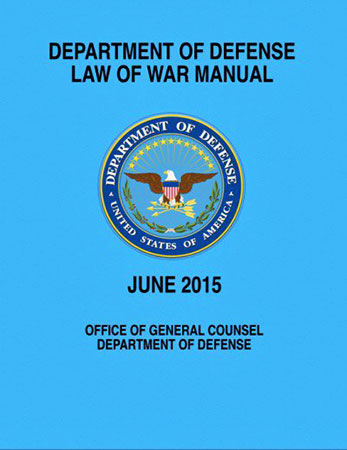
The new US Department of Defense Law of War Manual is essentially a
guidebook for violating international and domestic law and
committing war crimes.
The 1,165-page document, dated June 2015
(Department
of Defense - Law of War Manual), is not a statement of
existing law as much as a compendium of what the Pentagon wishes the
law to be.
Part One
by Tom Carter
03 November 2015
According to the manual, the "law of war" (i.e., the law of war
according to the Pentagon) supersedes international human rights
treaties as well as the US Constitution.
The manual authorizes the killing of civilians during armed conflict
and establishes a framework for mass military detentions.
Journalists, according to the manual, can be censored and punished
as spies on the say-so of military officials. The manual freely
discusses the use of nuclear weapons, and it does not prohibit,
...or other
indiscriminate weapons.
The manual might have more properly been titled A Manifesto for
Total War and Military Dictatorship.
The manual is an expression of the incompatibility of imperialist
militarism and democracy.
In the 25 years since the liquidation of
the USSR, and especially over the 14 years since the launching of
the so-called "war on terror," the United States has been almost
perpetually at war, seeking to offset its economic decline by
threats and military violence around the world.
The same government that orchestrated a coup led by fascists in the
Ukraine, that backs a military dictatorship and repression in Egypt,
and that supports mass killings and destruction in Gaza can hardly
be expected to remain true to the rule of law and democratic
principles at home.
Through both the
Bush and
Obama administrations, the "war on terror"
has been accompanied by a steady abrogation of democratic rights
within the United States, including,
-
a barrage of police state
legislation such as the Patriot Act
-
unrestricted spying on the
population by the National Security Agency and other agencies
-
the
militarization of the police
-
the establishment of precedents
for the detention and assassination of US citizens without
charges or trial
In this context, the Pentagon manual is a significant milestone in
the drive to establish the framework of
a police state.
In
his farewell address in 1961,
President Dwight D. Eisenhower famously warned about the
dangers posed by the "military-industrial complex." But America's
current military-corporate-intelligence establishment has
metastasized far beyond anything Eisenhower could have imagined.
Bloated with unlimited cash, dripping
with blood from wars of aggression, it boldly announces its
independence, its hostility to democracy and the rule of law, and
its readiness to carry out war crimes and other atrocities at home
and abroad.
The Pentagon manual reflects international imperialist tendencies.
Its authors state that it,
"benefited from the participation of
officers from the United Kingdom's Royal Air Force and the
Australian Royal Air Force on exchange assignments with the US
Air Force."
They continue:
"In addition, military lawyers from
Canada, the United Kingdom, New Zealand, and Australia reviewed
and commented on a draft of the manual in 2009 as part of a
review that also included comments from distinguished scholars."
(P. v)
The manual, which "reflects many years
of labor and expertise," applies to the entire Department of
Defense, which includes the,
-
Army
-
Navy
-
Air Force
-
Marine Corps
-
four national intelligence
agencies including the NSA
-
numerous other subordinate
departments and agencies,
...totaling 2.13 million active duty
personnel and 1.1 million reservists.
The manual notes,
"Promulgating a DoD-wide manual on
the law of war has been a long-standing goal of DoD lawyers."
(P. v)
The new document supersedes various
policy documents that had accumulated piecemeal within different
sections of the military and intelligence agencies.
It is the outcome of a continuous effort through both Democratic and
Republican administrations over a long period, including the Bush
and Obama administrations.
It was issued at the highest levels of
the state, having been prepared by a "Law of War Working Group"
that,
"is chaired by,
-
a representative of
the DoD General Counsel and includes representatives of the
Judge Advocates General of the Army, Navy, and Air Force
-
the
Staff Judge Advocate to the Commandant of the Marine Corps
-
the
offices of the General Counsels of the Military Departments
-
the Legal Counsel to the Chairman of the Joint Chiefs of Staff."
(Pp. v-vi)
The Pentagon general counsel is
Stephen W. Preston.
Preston was general counsel of the
Central Intelligence Agency (CIA) from 2009 to 2012, during which
time
the CIA covered up its own war crimes and obstructed efforts to
investigate its illegal torture program.
It is unclear to what extent the manual
has been reviewed or approved by any civilian authority.
The
significance of Nuremberg
The Law of War Manual is replete with references to the
Nuremberg
proceedings, a complex and significant event in the history of the
post-World War II period and the history of international law.
The manual opens with this tribute:
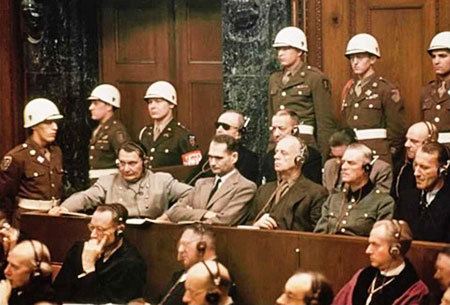
Nuremberg
tribunal
"After World War II, US military lawyers, trying thousands of
defendants before military commissions, did, in the words of
Justice Robert Jackson,
'stay the hand of vengeance and
voluntarily submit their captive enemies to the judgment of law'
in 'one of the most significant tributes that Power has ever
paid to Reason.'
Reflecting on this distinctive
history, one chairman of the Joint Chiefs of Staff observed that,
'[T]he laws of war have a peculiarly American cast.'
And it is also true that the laws of
war have shaped the US Armed Forces as much as they have shaped
any other armed force in the world." (P. ii)
The Pentagon of 2015 paying tribute to
the Nuremberg precedent is like the world's top-polluting
corporation expressing appreciation for efforts to protect the
environment.
If the precedent of Nuremberg were
applied impartially today, it would be necessary to arrest and
prosecute all of the top officials in the Pentagon, the world's
leading perpetrator of illegal aggression. After the triumph of the
Allies over Germany and Japan in the Second World War, the
victorious powers convened international tribunals to prosecute
major war criminals of the defeated powers.
The most famous trial took place from
November 20, 1945 to October 1, 1946 in Nuremberg, Germany and
featured the prosecution of,
-
Hermann Göring
-
Wilhelm Keitel
-
Joachim von Ribbentrop,
...and other leading Nazis.
There was an undeniable component of "victors' justice" in the
proceedings.
The same week in August 1945 that the
United States, the USSR, Britain and France forged an agreement to
establish the International Military Tribunal, the United States
committed some of the most heinous crimes of the war:
the
atomic bombings of Hiroshima and
Nagasaki.
Nonetheless, the democratic legal
positions espoused at Nuremberg stand in sharp contrast to the
corrupt and lawless American political establishment of today, which
asserts the right to,
-
abduct or assassinate any person without
charges or trial anywhere on earth
-
attack any country
"preventively"
-
spy on the entire world's
population
At the time of the Nuremberg tribunals, a majority view emerged
among the major Allied governments rejecting calls to execute
leading Nazis summarily on the basis of a "political decision."
Instead, the defendants were offered a
full and fair trial, during which they were permitted to call
witnesses, present evidence and argue in their own defense.
The most important principle that emerged from the Nuremberg
proceedings was the concept that the decision to launch a war of
aggression is the fundamental crime from which all other war crimes
flow. While the Nuremberg prosecutors exposed some of the greatest
crimes in human history, they maintained that the primary crime was
the decision by Hitler and his close associates to launch the
war in the first place.
The chief US prosecutor was Supreme Court Justice Robert Jackson.
His assistant, Telford Taylor,
emphasized in a memorandum to Jackson that the underlying
motivations and aims of the Nazis were not the decisive legal
questions:
"The question of causation is
important and will be discussed for many years, but it has no
place in this trial, which must rather stick rigorously to the
doctrine that planning and launching an aggressive war is
illegal, whatever may be the factors that caused the defendants
to plan and to launch."
In other words, launching a war of
aggression is a criminal act - a crime against peace - no matter
what arguments or policies are invoked to justify it.
Similarly, the Nuremberg prosecutors rejected the argument that
those who committed crimes were justifiably "following" or
"relaying" orders.
Nuremberg Principle IV reads,
"The fact that a person acted
pursuant to order of his Government or of a superior does not
relieve him from responsibility… provided a moral choice was in
fact possible to him."
These were powerful democratic
conceptions that reverberated long after the trials.
During the
Vietnam War, as Taylor himself noted in his memoir,
"thousands of young men
contended… that under the Nuremberg principles they were legally
bound not to participate in what they regarded as the United
States' aggressive war."
More recently, on July 12, 2013, NSA
whistleblower
Edward Snowden invoked the Nuremberg principles
to justify his refusal to conceal evidence of illegal spying.
"I believe in the principle declared
at Nuremberg in 1945," he said.
"Individuals have international
duties which transcend the national obligations of obedience.
Therefore, individual citizens have the duty to violate domestic
laws to prevent crimes against peace and humanity from
occurring."
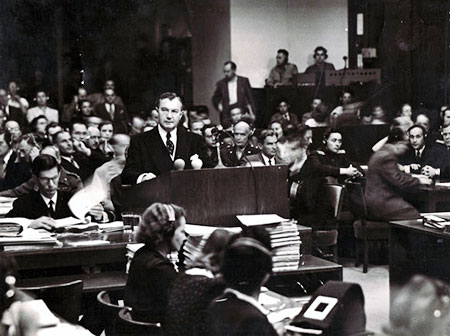
Justice Robert Jackson
at Nuremberg
The Nuremberg precedent expressed the confidence of the United
States as the dominant imperialist power emerging out of the Second
World War.
The American ruling class felt that it
could afford, under the circumstances, not only to assert democratic
principles, but to declare that these principles were universal,
applying to all countries, including the United States itself.
Thus, on July 23, 1945, Jackson told the International Conference on
Military Tribunals, the inter-allied body that prepared the trials,
"If certain acts of violation of
treaties are crimes, they are crimes whether the United States
does them or whether Germany does them, and we are not prepared
to lay down a rule of criminal conduct against others which we
would not be willing to have invoked against us." [1]
Seventy years later, America's leaders
have much less in common with jurists like Jackson and Taylor than
they do with Nuremberg's defendants.
While the Pentagon pays tribute to the
Nuremberg precedent, a partial list of the countries subjected to US
military violence since the liquidation of the USSR includes,
-
Iraq
-
Somalia
-
Haiti
-
the former Yugoslavia
-
Sudan
-
Afghanistan
-
Pakistan
-
Libya
-
Syria
-
Nigeria
-
Yemen
If launching a war of aggression is
illegal, arrest warrants should be forthcoming for,
...and their criminal co-conspirators.
All of these individuals should be in
the dock, right where Göring and company sat, on charges of war
crimes, crimes against humanity and crimes against peace.
Ample evidence exists for indictments. One powerful exhibit in such
a trial, for example, would be a November 27, 2001 memorandum by Donald Rumsfeld that contemplates various phony justifications for a
war of aggression against Iraq.
Under the profoundly
incriminating
headline "How start?"
Rumsfeld ponders the possibilities:
"Saddam moves against Kurds in
north? US discovers Saddam connection to Sept. 11 attack or to
anthrax attacks?
Dispute over WMD inspections?
Start now
thinking about inspection demands."
Rumsfeld's memorandum is one of many
proofs that there was a conspiracy to launch the invasion of Iraq in
2003 on the basis of lies and pretexts.
As a result of this illegal aggression,
hundreds of thousands of people lost their lives, if not more, and
millions have been turned into refugees. An entire society has been
devastated, leading to the rise of movements such as ISIS, and
trillions of dollars worth of property have been destroyed or
wasted.
The Nuremberg trials featured similar exposures of the criminal Nazi
conspiracy to invade Poland based on false pretenses. To provide a
casus belli for the war they had already decided to launch, the
Nazis staged a provocation known as
the Gleiwitz incident.
During the Nuremberg proceedings, this
incident was exposed as a staged attack on a German radio station by
German forces posing as Poles.
Hitler had boasted to his
generals:
"Its credibility doesn't matter. The
victor will not be asked whether he told the truth."
Do as I say,
not as I do
Notwithstanding its repeated invocations of the Nuremberg precedent,
the Pentagon's Law of War Manual features a strong element of
"do as I say, not as I do."
For example, on the subject of aggressive war, the document
declares,
"Aggression is the most serious and
dangerous form of the illegal use of force… Initiating a war of
aggression is a serious international crime." (P. 44)
This is a plain statement of the
Nuremberg precedent.
However, as one reads further, it emerges that this principle
applies only to countries other than the United States. The manual
notes that the US has refused to recognize the authority of the
International Criminal Court (ICC), under which the US could be
prosecuted for crimes of aggression.
The document states,
"The United States has expressed the
view that the definition of the act of aggression in the Kampala
amendments to the Rome Statute does not reflect customary
international law." (P. 45)
The US also expressed,
"concerns regarding the possibility
of the ICC exercising jurisdiction over the crime of aggression
without a prior determination by the Security Council that a
State has committed an act of aggression." (P. 1,112)
Such a Security Council determination,
of course, would be subject to a US veto.
The refusal of the United States to recognize the authority of the
ICC has deep historical significance.
The United States played a leading role
in establishing the Nuremberg precedent, but now refuses to submit
to its enforcement. This amounts to an admission that if the United
States were subject to an impartial application of the Nuremberg
precedent today, virtually all of official Washington would have to
be transported to jail.
It exposes as fraudulent all of
America's posturing as a kind of self-appointed "world policeman"
with the authority to sanction and attack other states that
allegedly violate international law.
Similarly, the Pentagon manual declares that torture is illegal:
"For example, it would be unlawful,
of course, to use torture or abuse to interrogate detainees for
purposes of gathering information." (P. 309)
But the document fails to explain how
the CIA came to implement a systematic and sadistic torture program
with the integral participation of high-level officials in the White
House, for which nobody has ever been held accountable.
The manual is full of caveats, disclaimers and weasel words.
For example:
"This manual is not intended to, and
does not, create any right or benefit, substantive or
procedural, enforceable at law or in equity against the United
States, its departments, agencies, or other entities, its
officers or employees, or any other person." (P.1)
In other words, the law of war does not
apply to us, only to you.
Passages like this reveal that the "law
of war" manual does not represent "law" as such, but policies
determined unilaterally by the Pentagon.
The Pentagon's hypocrisy (and sometimes plain incoherence) on the
subjects of torture and aggression is an expression of the crisis of
bourgeois rule in the United States and the contradictions of
American foreign policy.
On the one hand, the US constantly seeks
to dress up its imperialist projects in the costume of international
legality. To justify the first Gulf war (1991), America denounced
Iraq's invasion of Kuwait as illegal "aggression."
Just last year, American political leaders were denouncing Russian
"aggression" in Ukraine.
After the United States orchestrated a
coup in Ukraine, and while American commandos and dollars were
pouring in, John Kerry accused Russia of violating Ukraine's
"national sovereignty" and "territorial integrity."
Obama declared,
"There is a strong belief that
Russia's action is violating international law."
On the other hand, notwithstanding all
the talk about international law, national sovereignty, and
territorial integrity, America invades and bombs anywhere it sees
fit, without any regard for such considerations.
Where the United States can obtain
international legal approval for its aggression, it does so, but
otherwise the aggression takes place anyway.
The manual states,
"[T]he authority to take actions
under the law of war would be viewed as emanating from the
State's rights as a sovereign entity rather than from any
particular instrument of international law."
In other words, the United States can
freely ignore treaties and conventions and other "instruments of
international law" - such as the
Geneva Convention of 1949, which
the United States announced in 2002 that it would not follow - while
still claiming to adhere to its own version of international law.
At the Nuremberg trials, Jackson characterized the Nazi regime as
essentially a monstrous criminal enterprise, a giant illegal
conspiracy that invoked "law" only in the most tendentious, cynical
and self-serving manner.
The defendants, Jackson declared,
"are surprised that there is any
such thing as law. These defendants did not rely on any law at
all.
Their program ignored and defied all
law… International Law, natural law, German law, any law at all,
was to these men simply a propaganda device to be invoked when
it helped and to be ignored when it would condemn what they
wanted to do."
These words apply with full force to the
Pentagon and its manual. The manual explicitly gives the Pentagon a
green light at any future time to repudiate the principles it
ostensibly lays down.
Its authors write that the document does
not,
"preclude the Department from
subsequently changing its interpretation of the law." (P. 1)
Part Two
by Tom Carter
04 November 2015
A framework for military
dictatorship
The most menacing passages of the Pentagon's Law of War Manual
concern its relationship to other areas of law.
According to the manual, the law of war is separate
from and supersedes all other bodies of law, including international
human rights treaties and the United States Constitution's Bill of
Rights. This is nothing less than a formula for martial law,
military dictatorship and the suspension of the Constitution.
Citing a legal treatise entitled "Military Law and Precedents," the
manual states that the law of war can supersede the Constitution:
"'On the actual theatre of military operations,'
as is remarked by a learned judge, 'the ordinary laws of the
land are superseded by the laws of war. The jurisdiction of the
civil magistrate is there suspended, and military authority and
force are substituted.'
Finding indeed its original authority in the war
powers of Congress and the Executive, and thus constitutional in
its source, the Law of War may, in its exercise, substantially
supersede for the time even the Constitution itself …" (p. 10)
With the entire world declared to be the
"battlefield" in the "war on terror," this is a formula for the
Pentagon to impose military dictatorship on all of Planet Earth.
When the Pentagon refers to the "law of war," it is not referring to
historic precedents or international treaties. The phrase "law of
war," in the context of the manual, is a euphemism for "the law
according to the Pentagon."
Under the Pentagon's pseudo-legal framework, the "law of war" is an
independent source of legal authority that overrides all democratic
rights and sanctions arbitrary rule by the military.
The manual states:
"Although the law of war is generally viewed as
'prohibitive law,' in some respects, especially in the context
of domestic law, the law of war may be viewed as permissive or
even as a source of authority" (p. 14).

Nazi jurist Carl Schmitt
Changing a few words here and there, these doctrines could have been
copy-pasted from the writings of the Nazi "crown jurist" Carl
Schmitt (1888-1985). According to Schmitt's infamous "state of
exception" doctrine, under conditions of a national emergency, the
executive is permitted to override democratic protections and
disregard the rule of law.
Under this doctrine, democratic rights are not
formally abrogated, they are simply suspended indefinitely.
Schmitt's "state of exception" doctrine was used as a legal
justification for the 1933 "Act to Relieve the Distress of the
People and the Reich," also known as the "Enabling Act," which
codified Hitler's dictatorship.
The Pentagon manual invokes Schmitt's "state of exception" theory in
all but name.
Having claimed that the law of war is a "special"
discipline of law, as opposed to a "general" discipline, the manual
states that "the special rule overrides the general law" (p. 9).
For added effect, a Latin legal maxim saying the same
thing is cited:
"lex specialis derogat legi generali."
Thus, according to the Pentagon, the law of war is
the exception to the general "law of peacetime." Here we have
nothing less than a Nazi legal doctrine, incorporated by the
Pentagon into a major policy document.
"In some circumstances," the Pentagon's manual
states, "the rules in the law of war [i.e., the rules invented
by the Pentagon] and the rules in human rights treaties may
appear to conflict; these apparent conflicts may be resolved by
the principle that the law of war is the lex specialis during
situations of armed conflict [again, the state of exception],
and, as such, is the controlling body of law with regard to the
conduct of hostilities and the protection of war victims" (p.
9).
In other words, whenever the Pentagon's policies
conflict with human rights treaties, the human rights treaties
should be ignored.
The manual continues,
"Underlying this approach is the fact that the
law of war is firmly established in customary international law
as a well-developed body of law that is separate from the
principles of law generally applicable in peace" (p. 10).
The implication is that during wartime, America's
vast military establishment is a "separate," independent branch of
government, subject to its own rules and accountable to no one.
Despite the references to the war powers of Congress and the
executive under the American Constitution, the Pentagon's
conceptions are the opposite of the framework envisioned by the
framers of the Constitution. The Declaration of Independence, in its
list of grievances against the British monarch, charges that the
king,
"affected to render the Military independent of
and superior to the Civil power."
Both the Bush and Obama administrations
have been fond of invoking the phrase "commander in chief," which
appears in Article II of the US Constitution, in a manner that turns
its original meaning upside down.
The American revolutionaries described the president
as the commander in chief of the navy and army as a way of
expressing the subordination of the military to civilian authority.
This phrase was not meant to elevate the military, with the
president as its head, into some kind of supreme authority over the
rest of the state and the population.
The manual's reference to "principles of law generally applicable in
peace" has particularly sinister implications.
"Human rights treaties," according to the
Pentagon, are "primarily applicable to the relationship between
a State and individuals in peacetime" (p. 22).
Therefore, in "wartime" - including the "war
on terror" of indefinite scope and duration - human
rights treaties no longer apply.
This formula would allow the Pentagon to override more than just
human rights treaties. The manual's authors include the Bill of
Rights and other guarantees of civil liberties in the category of
laws that apply in "peacetime" only.
The arguments made by the manual justify suspending
the Bill of Rights altogether as a "peacetime" law that is
superseded for the duration of the "war on terror."
-
But why stop there?
-
Aren't elections also part of a system of
laws "generally applicable in peace?"
-
What about other civil liberties?
-
What about the right to freedom of speech, or
the right to form political parties?
-
What about the right to trial by jury?
-
What about the right to privacy, and the ban
on "cruel and unusual punishment?"
-
What about laws against racial
discrimination?
-
The right to a minimum wage?
Taken to its logical conclusion, the Law of War
Manual would justify imposing a military dictatorship, suspending
all democratic rights and rounding up and imprisoning all
dissenters.
Should any reader think this analysis far-fetched, it should be
remembered that one top American military man recently called for
setting up military internment camps for "disloyal" and
"radicalized" Americans.
Retired Gen. Wesley Clark (a Democrat)
declared:
"If these people are radicalized and they don't
support the United States and they are disloyal to the United
States, as a matter of principle, fine. It's their right, and
it's our right and obligation to segregate them from the normal
community for the duration of the conflict."
He added,
"We've got to cut this off at the beginning."
Clark's extraordinary proposals provoked no
significant discussion or disagreement within the political or media
establishment.
None of the current presidential candidates from
either major party has referred to Clark's statement, presumably
because they do not fundamentally disagree with it. There have been
no consequences for Clark's lobbying and consulting firm.
The Pentagon's manual makes clear that Clark was
merely testing the waters, revealing plans that have been broadly
discussed, developed and approved at the highest levels of the
state.

Antonin Scalia
When asked last year about the military internment of
Japanese-Americans during the Second World War, US Supreme Court
Justice Antonin Scalia responded,
"You are kidding yourself if you think the same
thing won't happen again." He added, in a formulation that
mirrors the Pentagon's manual, "In times of war, the law falls
silent."
The manual also features a heavy dose of the Obama
administration's trademark "balancing" rhetoric.
Pursuant to this approach, a basic democratic right
or legal principle will be affirmed in abstract terms. But then it
will be "balanced" against some authoritarian counter-principle,
with the result that the basic principle will be rendered
meaningless. The Obama administration has invoked this formula
repeatedly as its justification
for
NSA spying, as well as for drone assassinations .
The document states,
"Civilians may not be made the object of attack,
unless they take direct part in hostilities."
This seems clear enough, but then a "balancing"
formula is introduced.
"Civilians may be killed incidentally in military
operations; however, the expected incidental harm to civilians
may not be excessive in relation to the anticipated military
advantage from an attack, and feasible precautions must be taken
to reduce the risk of harm to civilians during military
operations" (p. 128).
In other words, after applying the "balancing"
formula, it turns out that it is acceptable to kill civilians if, on
balance, the expected "military advantage" outweighs the harm to
civilians.
This effectively makes the rule against killing
civilians meaningless. In practice, the "balancing" formula
translates to the unfettered power of military leaders to order mass
killing and destruction.
The brutality of
imperialist war
The manual features a chilling discussion of killing civilians.
According to the Pentagon, massacres of civilians are
permissible if they help achieve "operational objectives."
The authors take pains not to state that the killing of civilians is
prohibited per se. Instead, the manual indicates that "feasible
precautions" should be taken to "avoid" civilian casualties, which
should not be "excessive" or "unreasonable."
However, the manual defines "feasible precautions" as
merely,
"those that are practicable or practically
possible, taking into account all circumstances ruling at the
time, including humanitarian and military considerations" (p.
190).
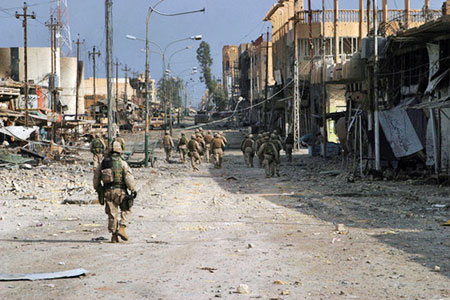
The Pentagon's manual authorizes mass killing of civilians
as in the assault on Fallujah
during the Iraq War
"For example," the document states, "if a commander determines
that taking a precaution would result in operational risk (i.e.,
a risk of failing to accomplish the mission) or an increased
risk of harm to their own forces, then the precaution would not
be feasible and would not be required" (p. 191).
This is a blank check for mass killings of civilians
if a military leader decides that failing to do so would be an
"operational risk."
If exterminating the population of a hostile city
would reduce the "risk of harm" to US forces, then the Pentagon
manual would allow it.
This "balancing" formulation appears to contradict previous
statements of American policy, such as the following remarks from
1987 by a State Department legal adviser:
"[C]ivilian losses are not to be balanced against
the military value of the target. If severe losses would result,
then the attack is forbidden, no matter how important the
target". [2]
The manual also codifies the tendentious "human
shields" doctrine, whereby civilian deaths are blamed on the targets
of indiscriminate bombing.
"A party that is subject to attack might fail to
take feasible precautions to reduce the risk of harm to
civilians, such as by separating the civilian population from
military objectives… the ability to discriminate and to reduce
the risk of harm to the civilian population likely will be
diminished by such enemy conduct". (p. 198)
This is merely a justification for collective
punishment by another name.
If the Pentagon identifies a "military objective" in
a densely populated area, then the military supposedly has the legal
right to obliterate the neighborhood with high explosives and blame
the civilian population for being "human shields."
Collective punishment is, under international law, a
war crime. It is designed to terrorize a population and discourage
resistance.
The manual expressly authorizes targeted killings.
"Military operations may be directed against
specific enemy combatants," the document states, adding, "US
forces have often conducted such operations". (p. 201)
In support of targeted killings, the manual cites
Obama's speech on May 2, 2011:
"Today, at my direction, the United States
launched a targeted operation against that compound [suspected
of housing Osama Bin Laden] in Abbottabad, Pakistan. A small
team of Americans carried out the operation with extraordinary
courage and capability. No Americans were harmed. They took care
to avoid civilian casualties. After a firefight, they killed
Osama bin Laden and took custody of his body". (p. 201)
The manual fails to mention that journalist
Seymour Hersh has exposed the account given in Obama's
speech as a pack of lies.
Censorship and targeting of
journalists as "unprivileged belligerents"
The manual's proposed treatment of journalists as spies has evoked
the only media attention to the document.
"Reporting on military operations," the manual
states, "can be very similar to collecting intelligence or even
spying". (p. 175)
The Pentagon goes on to authorize itself to "capture"
and "punish" journalists, forbid journalists to work anonymously,
and require that journalists obtain "permission" and "identification
documents" from the US military to conduct their work.
The manual states:
"A journalist who acts as a spy may be subject to
security measures and punished if captured. To avoid being
mistaken for spies, journalists should act openly and with the
permission of relevant authorities.
Presenting identification documents, such as the
identification card issued to authorized war correspondents or
other appropriate identification, may help journalists avoid
being mistaken as spies". (p. 175)
The document further states that journalists can be
subject to military censorship.
It declares:
"States may need to censor journalists' work or
take other security measures so that journalists do not reveal
sensitive information to the enemy. Under the law of war, there
is no special right for journalists to enter a State's territory
without its consent or to access areas of military operations
without the consent of the State conducting those operations".
(p. 175)
There is nothing here that would be out of place in
the code of laws of a totalitarian police state.
This legal framework, for example, would justify
setting up a military internment camp to imprison each journalist
who published material disclosed by Edward Snowden.
There is nothing in the manual that would prohibit
the Pentagon from launching drone strikes against targeted
journalists who are deemed to be acting as "spies." (If a
journalist's family and friends were killed in the drone strike, it
would be the journalist's fault for employing "human shields").
Do we exaggerate...?
An article appeared in the recent spring/summer issue
of the academic National Security Law Journal titled "Trahison des
Professeurs: The Critical Law of Armed Conflict/Academy as an
Islamist Fifth Column" [3 Nat'l Sec. L.J. 278 (2015)].
In this article, West Point law professor William
C. Bradford argues that academics who criticize the "war on
terror" are "aiding the enemy," such that they should be treated as
"unlawful combatants" under the law of war.
Bradford, a professor at the prestigious United States Military
Academy, goes on to argue that by criticizing the war on terror,
certain professors are working in,
"the service of Islamists seeking to destroy
Western civilization and re-create the Caliphates."
These professors, Bradford charges, are guilty of,
"skepticism of executive power," "professional
socialization," "pernicious pacifism," and "cosmopolitanism."
Bradford recommends firing "disloyal" professors and
imposing loyalty oaths at universities.
He further recommends arresting and prosecuting
professors for treason and for providing material support to
terrorism. Finally, he argues that "disloyal" professors and the
universities that employ them could be considered "lawful targets"
for military attack under the law of war.
Bradford has also advocated,
-
a military coup ("What conditions precedent
would be required before the American military would be
justified in using or threatening force to oust a US
president…?")
-
genocide ("total war" until "the political
will of Islamist peoples" is broken, or until "all who
countenance or condone Islamism are dead")
The latter policy would include the targeted
destruction of "Islamic holy sites."
The journal subsequently repudiated Bradford's article, calling it
an "egregious breach of professional decorum," and Bradford resigned
from West Point on August 30. However, the episode provides a
glimpse of what the Pentagon has in mind for its critics under the
"law of war."
Bradford's fascistic rants simply represent the
doctrines expressed in the Law of War Manual taken to their logical
conclusions.
The persecution of journalists such as Glenn Greenwald (and
his partner David Miranda) and Julian Assange, together with
whistleblowers such as Edward Snowden and Bradley (Chelsea)
Manning, has already made clear that the American government
will treat the exposure of official criminality as "espionage" and
"aiding the enemy."
The Pentagon's manual codifies this position and
authorizes the military to carry out repressive measures against
journalists.
The Committee for the Protection of Journalists (CPJ) issued
a statement on July 31 protesting the manual, pointing to the rising
numbers of journalists killed and maimed while covering armed
conflicts.
"The Obama administration's Defense Department,"
the CPJ wrote, "appears to have taken the ill-defined practices
begun under the Bush administration during the War on Terror and
codified them to formally govern the way US military forces
treat journalists covering conflicts."
It is significant that the words "freedom of speech"
and "freedom of the press" do not appear anywhere in the Pentagon's
manual.
In a section setting forth the Pentagon's authority as an "Occupying
Power," the manual states that,
"for the purposes of security, an Occupying Power
may establish regulation of any or all forms of media (e.g.,
press, radio, television) and entertainment (e.g., theater,
movies), of correspondence, and of other means of communication.
For example, an Occupying Power may prohibit
entirely the publication of newspapers that pose a threat to
security, or it may prescribe regulations for the publication or
circulation of newspapers of other media for the purpose of
fulfilling its obligations to restore public order". (pp.
759-60)
A footnote includes the caveat that,
"this sub-section focuses solely on what is
permitted under the law of war and does not address possible
implications of censorship under the First Amendment of the
Constitution."
Presumably, the authors would contend that the First
Amendment applies only in "peacetime," and is "superseded" by the
Pentagon's "lex specialis" for the duration of the "war on terror."
Part Three
by Thomas Gaist
05 November 2015
A recipe for total war and
military dictatorship
The Department of Defense (DOD) Law of War
Manual represents the most advanced ideological expression of the
striving of US imperialism to dominate and control the entire world
by means of military force.
By authorizing the Pentagon to occupy, wage war against and impose
its own version of "law" in every corner of the planet, the DOD
manual merely formalizes the world-hegemonic agenda of US
imperialism and points to its logical endpoint.
"US capitalism is up against the same problems
that pushed Germany in 1914 on the path of war. The world is
divided? It must be re-divided. For Germany it was a question of
'organizing Europe.'
The United States must 'organize' the world.
History is bringing humanity face to face with the volcanic
eruption of American imperialism."
This was written by the founder of the Fourth
International, Leon Trotsky, in 1934.
From the mid-1970s onward, the US ruling class has engaged in a
relentless militarization drive aimed at overcoming through armed
force its economic decline.
This was also foreseen by Trotsky, who wrote:
"In the period of crisis the hegemony of the
United States will operate more completely, more openly and more
ruthlessly than in the period of boom.
The United States will seek to overcome and
extricate herself from her difficulties and maladies primarily
at the expense of Europe, regardless of whether this occurs in
Asia, Canada, South America, Australia, or Europe itself, or
whether this takes place peacefully or through war."
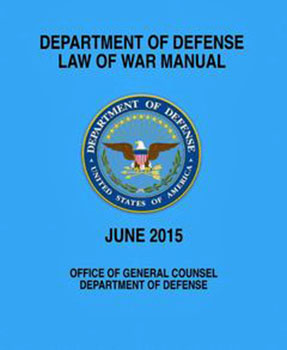
Department of Defense Law of War
Manual
The Law of War Manual, which elaborates protocols for military
operations in every corner of the globe by the Pentagon and its
proxy forces, amounts to a manifesto for this process, set down in
legal jargon.
If the guidelines laid out in the manual are allowed
to be implemented - that is, if the international working class does
not intervene in time on the basis of a revolutionary program - then
humankind faces a future dominated by concentration camps, slaughter
on an unprecedented scale, and, ultimately, a nuclear holocaust.
In essence, the DOD manual represents a comprehensive statement of
the only "solution" to the world crisis that the imperialist cliques
in Washington and on Wall Street are capable of offering.
Total war
The first two articles in this series have drawn the parallels
between the Department of Defense Law of War Manual and the legal
and political ideology of Nazi Germany.
It has been shown that the very same fascist
conceptions rejected by leading American jurists at the Nuremberg
trials have, in the form of the DOD manual, been codified as
official state policy at the highest levels of the American
government.
Later sections of the DOD manual, those covering the practices of US
military operations, make clear that the scorched earth methods
employed by the Nazis against the populations of Europe, the Soviet
Union and North Africa are now embraced and defended by the Pentagon
high command.
The manual overturns central tenets of international law designed to
place restraints on the use of military violence.
On the basis of the Oxford English Dictionary
definition of total war as "a war that is unrestricted in terms of
the weapons used, the territory or combatants involved, or the
objectives pursued, especially one in which the laws of war are
disregarded," one can state without hesitation that total war has
become the central policy of the DOD.
Every form of military activity conventionally associated with total
war - a concept that emerged during the 19th
century before finding its consummate expression in the mayhem and
destruction perpetrated by both the fascist and "democratic"
imperialist governments during the Second World War - is explicitly
or implicitly allowed by the Pentagon guidelines.
Every nominal restriction on the DOD's war-making powers included in
the manual is accompanied by caveats that confer virtually unlimited
discretion on US military commanders to employ violence in the
service of US strategic aims.
The manual carefully avoids any language that might
discourage commanders from planning offensive operations. There are
gaping loopholes in every section designed to instill confidence
that there will be no penalty for the indiscriminate use of force.
The manual authorizes US commanders to engage in strategic bombing,
attacks on civilian commercial infrastructure, blockades and sieges.
It authorizes the establishment of mass detention and forced labor
camps.
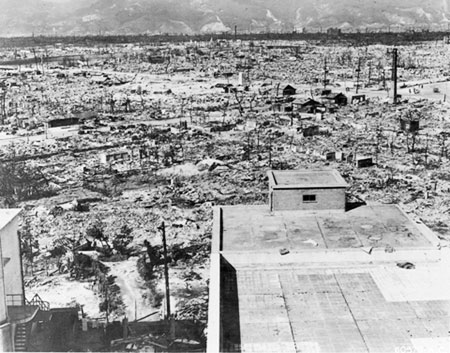
Hiroshima in 1945
Of course, throughout its history, US imperialism has committed
horrific violations of international laws along these lines,
carrying out collective punishment, mass slaughter of populations,
and the destruction of urban areas in,
-
Germany
-
Japan
-
Korea
-
Vietnam
-
Cambodia
-
most recently, Iraq
The military campaign launched against Iraq in 2003
reduced one of the most advanced economies in the Middle East to a
level of social development comparable to that of the poorest
countries in the world.
Some 4-5 million Iraqis were killed, displaced or
disappeared as a result of the US war and occupation. More than half
of Iraqi doctors were killed or forced to flee the country. Reports
published in 2007 by Iraq's Statistical Bureau showed that, four
years after the war was launched, fully 43 percent of Iraqis were
living in "absolute poverty," without reliable access to food,
housing or clothing.
Prior to the release of the DOD manual this year, however, the US
high command employed such methods in defiance of its own
regulations, which still included clearly worded prohibitions
against wanton destruction of civilian infrastructure and
populations.
The last comprehensive document on military law
issued by the US Department of Defense, the 1956 US Army Field
Manual on the Law of Land Warfare, still maintained that military
operations could not be launched if it was known in advance that
they would lead to large-scale civilian casualties.
While including formal prohibitions against the slaughter of
civilians similar to those contained in the 1956 document, the new
manual provides conceptual loopholes based on notions of "military
necessity," "expected military advantage," etc.
The publication of the DOD manual is thus enormously significant as
an official assertion by the US ruling elite of its "right" to
demolish entire societies and peoples in pursuit of its political
goals.
Undoubtedly, the DOD manual was crafted with an eye
toward legalizing, after the fact, the crimes committed against Iraq
by US imperialism.
Under the manual's guidelines, direct mass killing of civilians is
effectively legalized, so long as the relevant US military officers
consider that attacks around or against civilian targets are
weighed,
"in relation to the concrete and direct military
advantage expected to be gained." (P. 187)
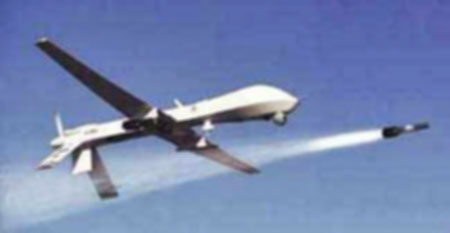
Predator drone firing a Hellcat
missile
Commanders are authorized to conduct operations that they know will
lead to large numbers of civilian deaths, as long as their
subjective assessment finds that such operations contribute to,
"the broader imperatives of winning the war."
This applies even when the "military advantage" to be
gained from a proposed attack could not be understood by an "outside
observer," i.e., on the basis of any objective or universal
criteria.
"The military advantage expected to be gained
from an attack might not be readily apparent to the enemy or to
outside observers because, for example, the expected military
advantage might depend on the commander's strategy or
assessments of classified information," the manual states. (P.
213)
"The weighing or comparison between the expected incidental harm
and the expected military advantage does not necessarily lend
itself to empirical analyses," the document adds. (P. 128)
"In less clear-cut cases, the question of whether the expected
incidental harm is excessive may be a highly open-ended legal
inquiry, and the answer may be subjective and imprecise," the
manual declares. (P. 245)
In defining what constitutes a legitimate military
target, DOD employs a definition that is so broad as to encompass
the entire economy and civilian population of enemy states.
The manual authorizes destruction of basic
infrastructure, including housing stock, power generation
facilities, water facilities, and food supply chains of enemy
states.
Any object that contributes to the "war-fighting
capacity" of the enemy nation, even in an indirect manner, is
declared by the manual to be a legitimate target. (P. 206)
"The term 'military objective' means combatants
and those objects during hostilities which, by their nature,
location, purpose, or use, effectively contribute to the
war-fighting or war-sustaining capability of an opposing force,"
the manual reads.
"It is not necessary that the object provide immediate tactical
or operational gains or that the object make an effective
contribution to a specific military operation. Rather, the
object's effective contribution to the war-fighting or
war-sustaining capability of an opposing force is sufficient…
The advantage need not be immediate." (P. 210)
"The law of war does not require that attacks on a military
objective be conducted near ongoing fighting, in a theater of
active military operations, or in a theater of active armed
conflict." (P. 199)
In a critique of the target selection practices
called for by the manual, entitled "The Defense Department Stands
Alone on Target Selection," Professor Adil Haque of the
Rutgers School of Law-Newark notes that the manual effectively
authorizes US commanders to carry out attacks regardless of the
civilian death toll that is likely to result.
"A deeply troubling provision in the Defense
Department's new Law of War Manual suggests that commanders are
not legally required to minimize civilian casualties when
selecting between different targets," Haque writes.
"The United States is not legally required to
select targets so as to reduce collateral harm to civilians."
Large sections of the manual are devoted to siege,
enforced starvation and occupation of densely populated urban areas.
It authorizes the erection of ghettos and security cordons to
restrict the movement of civilians.
"Starvation is a legitimate method of warfare,"
the DOD manual states. (P. 291) "In particular, it is
permissible to seek to starve enemy forces into submission."
During siege warfare, US military commanders are
authorized, among other things, to destroy supply lines that are
relied on by the civilian population for food and other essential
goods.
"States may institute general food control
programs that involve the destruction of crops and the adequate
provision of the civilian population with food," the manual
reads in the section entitled "Starvation of Enemy Forces Not
Prohibited." (P. 1,037)
It advises US officers to allow passage of "certain
categories of civilians," implying that much of the civilian
population can be left for dead inside the encircled area.
Commanders are authorized to completely isolate urban areas,
refusing the movement of even the most basic humanitarian goods into
the siege zone.
"A commander of an encircling force is not
required to agree to the passage of medical or religious
personnel, supplies, and equipment," the manual states. (P. 316)
The implications of this doctrine were already
demonstrated in the US military's 2004 siege of Fallujah in Iraq.
Tens of thousands of Iraqi men between the ages of 15
and 55 were prevented from fleeing the city prior to a devastating
US bombardment that destroyed some 60 percent of the city's
buildings, irradiated the entire area with toxic munitions
byproducts, and permanently reduced the population by as much as 50
percent.
The manual authorizes the use of illegal weapons, another practice
commonly understood as a feature of total war, including cluster
bombs and nuclear weapons, against a range of,
"military objectives," including "mountain
passes, hills, defiles, and bridgeheads, villages, towns, or
cities" whose seizure is militarily important. (P. 215)
"Under certain circumstances, it may be advantageous to use
cluster munitions," the document reads.
"The United States has determined that its
national security interests cannot be fully ensured consistent
with the terms of the Convention on Cluster Munitions."
Employing a formula that becomes all too familiar to
any reader of the manual, the document openly authorizes use of
nuclear weapons based on calculations of "military advantage."
"Attacks using nuclear weapons must not be
conducted when the expected incidental harm to civilians is
excessive compared to the military advantage expected to be
gained," the document states. (P. 420)
Such formulations amount to a green light to do
anything.
Would the DOD high command consider the destruction
of China's key military and economic infrastructure to be militarily
advantageous? Of course, and therefore nuclear attacks would be
justified.
In fact, the DOD's Air Sea battle plan envisions a crushing first
strike against the Chinese mainland, using a level of force so
overwhelming as to prevent any possibility of retaliation by the
Chinese military.
Mass detention and
concentration camps
Brushing aside democratic legal principles that have been developed
over centuries, the manual asserts the absolute power of the US
military-security apparatus to detain civilians anywhere on the
planet.
"Detention is fundamental to waging war or
conducting other military operations," the Pentagon lawyers
assert in the opening lines of the section "Detention: Overview
and Baseline Rules." (P. 515)
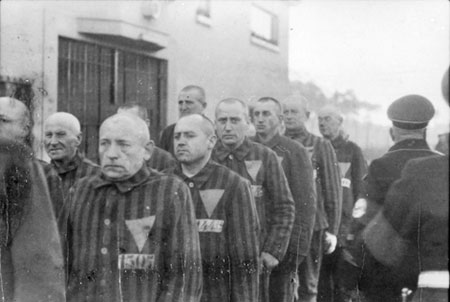
Prisoners in the Sachsenhausen
concentration camp, 1938
While the executive branch has already asserted similar prerogatives
with the passage of the National Defense Authorization Act of 2012,
it remains significant that the DOD now openly maintains its own
sweeping powers to act as an independent branch of government,
exercising essentially limitless authority.
The manual maintains that the Defense Department may re-interpret
and negate international agreements that prohibit extra-legal
arrests and detentions, upholding the unlimited right of the
American national state to nullify well-established international
laws.
The DOD lawyers go so far as to cite relevant portions of
international law that directly contradict their own positions
before sweeping them aside as incompatible with the US government's
interpretations.
"Anyone who is deprived of his liberty by arrest
or detention shall be entitled to take proceedings before a
court, in order that that court may decide without delay on the
lawfulness of his detention and order his release if the
detention is not lawful," a passage from the International
Covenant on Civil and Political Rights (ICCPR), reprinted in the
manual, states. (P. 50f)
The document then declares that the US government has
"understood" such prohibitions not to apply to its own policies.
As far as DOD and the US government are concerned,
the manual makes clear, the content of international laws is
determined by the way in which such laws are re-understood by top US
military attorneys and bureaucrats.
"For example, the right to challenge the
lawfulness of an arrest before a court provided in Article 9 of
the International Covenant on Civil and Political Rights (ICCPR)
would appear to conflict with the authority under the law of war
to detain certain persons without judicial process or criminal
charge," the manual reads.
"However, the United States has understood Article 9 of the
ICCPR not to affect a State's authorities under the law of war,
including a State's authority in both international and
non-international armed conflicts to detain enemy combatants
until the end of hostilities." (P. 50)
The manual goes on to outline authorizations for DOD
to create specific legal instruments in order to overcome any
remaining legal obstacles to its detention powers, allowing for the
creation of "Ad Hoc Legal Instruments or Frameworks" and "Special
Courts."
According to the manual,
"Detaining Powers" may segregate detainees in
prison camps based on racial and ethnic criteria.
"Detainees may be segregated into camps or camp
compounds according to their nationality, language, and customs,
and the Detaining Power may use other criteria to segregate
detainees for administrative, security, intelligence, medical,
or law enforcement purposes." (P. 498)
US military authorities are empowered to carry out
mass resettlement of populations for "imperative military reasons."
Under the heading "Displacement of the Civilian
Population,"
the manual states: "The Occupying Power may
undertake total or partial evacuation of a given area if
required for the security of the population or for imperative
military reasons." (P. 778)
And further:
"The displacement of the civilian population
shall not be ordered for reasons related to the conflict unless
the security of the civilians involved or imperative military
reasons so demand." (P. 1,035)
Martial law and occupation
The manual outlines procedures for military occupation and
imposition of martial law on subjugated territories.
Protocols are formulated in extremely general terms,
making clear that the entire world, including the US "Homeland," is
viewed as actual or potential Occupied Territory.
Inhabitants of territory under US military rule must submit
unconditionally to the dictates of the "Occupying Power," rendering
"strict obedience to the orders of the occupant," the manual states
in the section "Suspension and Substitution of Governmental
Authority."
US commanders may,
"exercise authority over all means of public and
private transportation, whether land, waterborne, or air, within
the occupied territory, and may seize them and regulate their
operation," the manual asserts.
Lest there be any illusions that protocols for
military occupation and suspension of constitutional government do
not apply within the borders of the United States, the manual
announces that the DOD-promulgated law of war policies are being
integrated into US domestic law.
"Law of war requirements have also been
incorporated into domestic law, policy, regulations, and
orders," the document states (P. 1,057)
In the section on "Non-International Armed Conflict,"
the manual develops another conceptual loophole that enables US
forces to violate the Geneva Conventions and other international
laws when engaged in operations against persons or organizations
that are not formally part of an internationally recognized state.
Whereas the manual assigns some limited relevance to international
laws in relation to military conflicts against rival national
states, non-international armed conflicts are said to be conducted
under the essentially limitless authorities assigned by the manual
to the US government as the world's most powerful national state.
Non-state actors cannot claim the legal status of national
governments and are essentially considered to be legally naked, that
is, fully at the mercy of the US government and not entitled to the
minimal protections afforded to captured enemy POWs.
"The sovereign equality of States is not
applicable in armed conflicts between a State and a non-State
armed group. A State may exercise both sovereign and belligerent
rights over non-State armed groups." (P. 1,025)
"The limits imposed by international law on a State's action
against non-State armed groups do not alter the basic principle
that the State may exercise its sovereign powers against the
non-State armed group…
"Although, during international armed conflict, lawful
combatants are afforded certain immunities from the enemy
State's jurisdiction, persons belonging to non-State armed
groups lack any legal privilege or immunity from prosecution by
a State that is engaged in hostilities against that group." (P.
1,025)
Such language serves to put US officers on notice
that, in confronting insurrectionary movements by the American and
international working class, they are permitted to cast aside all
restraints conventionally associated with the law of war as it has
evolved over centuries.
Part Four
by Thomas Gaist
06 November 2015
Pentagon embraces "just following
orders" justification for war crimes
As previous segments have noted, key conceptions advanced in the
Pentagon's Law of War Manual amount to little more than a rehash of
authoritarian legal theories upheld by the Nazi regime and other
fascist governments.
The Department of Defense (DOD) manual's protocols for enforcing the
law of war and establishing the legality of military orders fall
into this category, bearing an eerie resemblance to the doctrine
asserted by the main defendants at the Nuremberg Tribunal - that
they were "just following orders."
In flat contradiction to the principles upheld at
Nuremberg, subordinates are instructed to "presume" that commands
are lawfully issued and are granted sweeping immunity from
responsibility for war crimes committed under orders from the
military brass.
US military personnel are instructed and trained to regard orders
emanating from the command unit as legal by default, the DOD manual
states. The document states:
"Subordinates, absent specific knowledge to the
contrary, may presume orders to be lawful. The acts of a
subordinate done in compliance with an unlawful order given by a
superior are generally excused." (P. 1,148)
"Except in such instances of palpable illegality, which must be
of rare occurrence, the inferior should presume that the order
was lawful and authorized and obey it accordingly," one footnote
declares, citing Winthrop Military Law and Precedents in defense
of this position. (P. 1,058f)
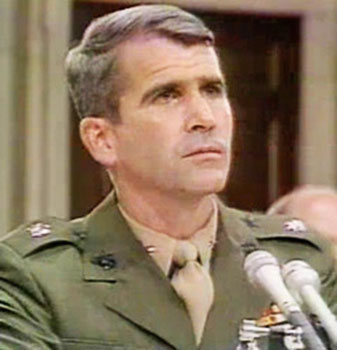
Lt. Col. Oliver North testifying during the
Iran-Contra congressional hearings
in 1987
In cases of ambiguity, junior officers are encouraged to concoct an
"interpretation" of orders that might render them more lawful.
"Commands and orders should not be understood as
implicitly authorizing violations of the law of war where other
interpretations are reasonably available," the manual states.
The authors write that the law is enforced through
"military instructions, regulations and procedures" issued by the
Pentagon.
"The implementation of law of war treaties and
obligations through military instructions, regulations, and
procedures has the effect of making such rules enforceable
because military personnel are required to comply with duly
issued instructions, regulations, and procedures," the manual
states. (P. 1,069)
These formulations point to the fact that there is no
real distinction between the decrees of the Pentagon bureaucracy and
the DOD "Law of War", which, far from being actual law, is merely a
special collection of military orders issued by cabals of military
lawyers and career defense officials.
Planning for mass
repression at home
In addition to its international significance, the Law of War Manual
summarizes and integrates plans for mass repression and martial law
within the US itself that have been developed since the late 1960s
by the US Defense Department in direct response to the political
radicalization of the working class and layers of the middle class.
The procedures governing mass detention enumerated in the Law of War
Manual have already been partially worked out by numerous agencies
and programs run by the Department of Defense Civil Disturbance
Directorate, the Federal Emergency Management Agency (FEMA),
and the Department of Homeland Security, which now
incorporates FEMA.
The driving impetus behind these preparations has been the threat of
insurrectionary struggles by the working class and the associated
growth of anti-war sentiment within the population.
In the aftermath of the 1967 urban upheavals, DOD established the
Directorate of Civil Disturbance Planning and Operations as a
permanent body to oversee plans for suppression of domestic unrest
by federal troops.
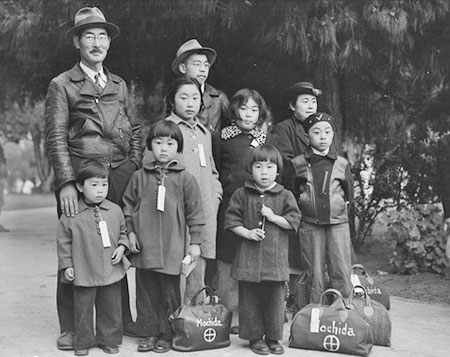
The Mochida family
awaits evacuation to an internment
camp in 1942
Beginning in 1968, US military planners developed frequent updates
to the US Army Civil Disturbance Plan, codenamed "Operation
Garden Plot."
Updated on an almost yearly basis since then, Garden
Plot calls for the rapid deployment of federal military forces to
every major city in the US, with initial contingents of troops
scheduled to arrive within six hours of call-up.
The plan was touted by its original architects as a
"counterrevolutionary" response to the mass strikes, anti-war
protests, ghetto uprisings, and radicalization of university
campuses during this period.
Garden Plot operations were to be activated in response to,
"strikes, civil disturbances and labor
disturbances which affect military installations or other
strikes or labor and civil disturbances of sufficient magnitude
to indicate a probable employment of Federal troops to preserve
or restore order."
The document continued:
"Civil disturbances which are beyond the control
of municipal or state authorities may occur at any time.
Dissatisfaction with the environmental conditions
contributing to racial unrest and civil disturbances and
dissatisfaction with national policy as manifested in the
anti-draft and anti-Vietnam demonstrations are recognized
factors within the political and social structure.
As such, they might provide a preconditioned base
for a steadily deteriorating situation leading to demonstrations
and violent attacks upon the social order."
Garden Plot called for "saturation of areas with
police and military patrols," continuous helicopter sorties over
targeted areas, and deployment of artillery, tanks, tactical air
support and psychological warfare against demonstrators in US
cities.
"Disturbances requiring Federal intervention will
occur simultaneously in up to 25 objective areas throughout the
CONUS [continental United States], necessitating the employment
in each objective area of up to five 2,000-man brigades plus
supporting troops, with the exception of Washington, D. C., when
forces totaling 30,000 troops may be employed," the plan stated.
(Quoted from "US Department of the Army Civil
Disturbance Plan 'GARDEN PLOT' 10-September-1968").
Planning for Continuity of Government (COG), a
euphemism for martial law,
"assumed its current shape in response to the
mobilization of US Army intelligence and the CIA against
left-wing Americans during the civil disorder of the 1960s and
1970s," as Peter Dale Scott noted in his study of the growth of
the military-intelligence apparatus during the postwar era
(9/11: Wealth, Empire and the Future of
America, 11)
To provide intelligence for domestic
counterinsurgency operations, during the 1960s and 1970s the DOD
oversaw the establishment of Emergency Operations Centers (EOC),
staffed by cells of federal military intelligence analysts
maintaining constant communication with the Pentagon's "domestic war
room" in National Guard headquarters across the country.
These initiatives were jumpstarted in May 1971 with the
establishment of the California Specialized Training Institute
(CSTI), authorized by then-Governor Ronald Reagan.
Between 1971 and May 1975, more than 4,000 officials
from the National Guard, the Army, police agencies and private
corporations received training in "emergency preparedness" at the
CTSI in San Luis Obispo.
As the social counterrevolution gained steam after 1975, martial law
planning was steadily embedded in the upper reaches on the state
apparatus and institutionalized through further executive orders.
FEMA and REX 84
The past four decades have witnessed a feverish build-up of
authoritarian legal and political instruments that have been
entrenched as a permanent part of the executive branch.
Virtually every year has seen new orders and
protocols developing the scaffolding of a police state.
The duration and continuity in such planning demonstrates that it is
not simply the initiative of this or that reactionary bourgeois
politician, but rather something that emerges organically from class
relations within the United States and the deteriorating position of
American imperialism in the world.
The Law of War Manual expands upon existing DOD plans authorizing
mass detention of US citizens, dating from at least the 1970s.
The 1978 update of the US Army Civil Disturbance Plan
called in no uncertain terms for DOD to prepare to establish
detention camps in liaison with state and local agencies.
"Plans for detention assistance to civilian
authorities will range from the absolute minimum, such as
assisting civil police in the guarding of civilians apprehended
and awaiting transfer or en route to detention facilities, to
the establishment and operation of temporary detention
facilities to supplement those operated by civil authorities,"
the document stated.
The civilian apparatus of the US government was
increasingly remodeled over decades to serve as the administrative
wing of the emerging military dictatorship-in-waiting.
Executive decrees issued by the Carter administration
consolidated civil and military planning for "national emergencies"
under the control of the newly created
Federal Emergency Management Agency (FEMA).
Executive Order 12148, signed by President Carter in
1979, mandated continuous joint preparations by FEMA and DOD aimed
at "civil defense planning."
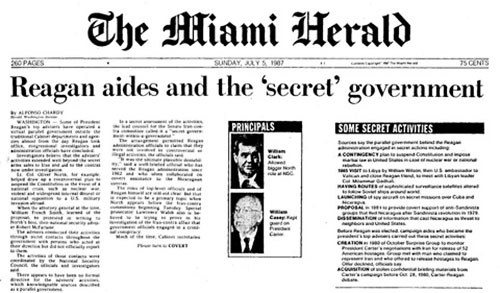
The Miami Herald of July 5, 1987
documented the existence of a
"parallel government behind the
Reagan administration
engaged in secret actions
including ... a contingency plan to suspend
the Constitution and impose
martial law in the United States
in case of nuclear war or national
rebellion."
Transcript here.
In the early 1980s, the Reagan administration presided over a
further entrenchment of martial law planning cadres within the
highest levels of the executive branch.
In 1981, CTSI lead planner Colonel Louis Giuffrida
was appointed "emergency czar" by President Reagan.
Giuffrida had attracted favorable attention from political forces
assembled around the future President Reagan for his role in the
development of the CTSI and his US Army War College thesis paper,
"National Survival/ Racial Imperative," which envisioned plans for
detention of millions of "American Negroes" in "assembly centers or
relocation camps."
In December 1982, Reagan approved the formation of the Emergency
Mobilization Preparedness Board (EMPB) to serve as a planning
body for an expanded "Civil/Military Alliance in Emergency
Management," headed by FEMA and DOD.
It was while sitting as a member of the EMPB that Lt. Colonel Oliver
North of Iran-Contra notoriety developed the REX 84 plan, a major
precursor to the 2015 Law of War Manual.
As described by Alfonzo Chardy, a journalist who exposed the
plans in a 1987 article for the Miami Herald, REX 84 outlined
procedures for,
"suspension of the Constitution, turning control
of the government over to the Federal Emergency Management
Agency, emergency appointment of military commanders to run
state and local governments, and declaration of martial law
during a national crisis."
Public exposure of REX 84 by Chardy and its mention
during a congressional hearing on the Iran-Contra scandal, which
involved the secret and illegal funding of the Nicaraguan Contras by
the US government, did not succeed in slowing the elaboration of the
legal and political foundations for direct military rule.
Expanding upon the Carter administration's Executive Order 12171,
Executive Order 12681, signed by President George H. W. Bush
in 1989, exempted FEMA's National Preparedness Directorate from the
National Labor Relations Act, authorizing FEMA to develop forced
labor programs and oversee the direct takeover of sections of the
economy by the military and intelligence agencies.
The twenty-five years since the dissolution of the Soviet Union have
witnessed a further intensification of preparations for military
occupation of the continental United States.
The Bush I, Clinton, and Bush II administrations all
oversaw large-scale mobilizations of the US military against the
domestic population.
In April 1992, the Bush I administration ordered thousands of
federal soldiers, Marines and intelligence agents to occupy Los
Angeles in response to the riots that began on April 29.
During the Republican National Convention in August
of 2000, DOD placed federal military units on standby,
"to execute Operation Garden Plot and quell any
serious civil disturbances," according to confidential FEMA
documents acquired by Wired News.
(Declan McCullagh, US military poised to
respond to attack on GOP convention, Wired News, August 2000)
In April 2002, the Bush administration authorized the
creation of the US Northern Command (NORTHCOM) as part of a new
"Unified Command Plan."
NORTHCOM, the first full-blown US military command
focusing on the continental United States, was the descendant of
military commands tasked with preparing and developing Garden Plot
over the previous period.
A NORTHCOM planning document leaked in 2010, titled
CONPLAN 3501, showed that the command had rapidly developed a highly
detailed division of labor for military occupation of the
continental United States during the years following its formation.
Conclusion
The Law of War Manual is a watershed in the breakdown of American
bourgeois democracy and the repudiation by the ruling elite of the
democratic principles laid down in the Constitution.
Outside of a brief protest by the New York Times, in
a single editorial, the corporate-controlled media has said nothing
about the new codification of Pentagon doctrine. Nor have any of the
presidential candidates, Republican or Democratic, from the
"libertarian" Rand Paul to the supposed "democratic
socialist" Bernie Sanders.
As envisioned by the manual, the US military apparatus becomes the
ultimate legal authority on the planet, making up and modifying its
own "laws" in the course of military operations aimed at subjugating
the entire world population to its dictates.
Rather than the outcome of megalomania on the part of US generals
and officials, the manual flows from the objective logic of the
development of capitalism as a world-historic social formation.
As Vladimir Lenin explained in his epochal work, The State
and Revolution, beginning from the late 19th
century, the development of the capitalist state in general has been
characterized by the,
"perfecting and strengthening of the 'executive
power,' its bureaucratic and military apparatus."
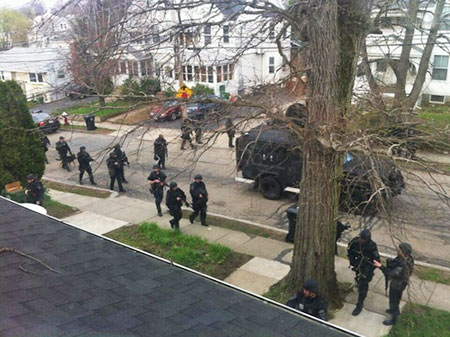
Military forces doing
house-to-house searches
during the Boston lockdown in
April, 2013
[Photo: rilymoskal7]
Despite differences in the forms of government of various capitalist
nations, Lenin explained, there remains a clear universal tendency
toward the increasing centralization of power in the hands of the
vast and permanent bureaucracies that constitute, in every
capitalist state, a veritable "permanent government" that remains in
power no matter which parties or individuals have won the latest
round of elections.
In another of his central works, Imperialism: The Highest Stage
of Capitalism, Lenin identified the essential economic processes
driving this development.
From the 1870s onward, the growth of monopolies and
the extraction of super-profits from colonial or semi-colonial
countries ensured the ever-greater concentration of wealth and power
in the hands of financial oligarchies.
As Leon Trotsky, co-leader with Lenin of the Russian
Revolution, explained in the Manifesto of the First Congress of the
Comintern, the major US and European finance houses integrated
themselves with the military agencies of the bourgeois state during
and after the First World War.
"Finance capital, which plunged mankind into the
abyss of war, itself underwent a catastrophic change in the
course of this war," Trotsky wrote in 1919.
"During the course of the war, the
regulating-directing role was torn from the hands of these
economic groups and transferred directly into the hands of the
military-state power. The distribution of raw materials, the
utilization of Baku or Rumanian oil, Donbas coal, Ukrainian
wheat, the fate of German locomotives, freight cars and
automobiles, the rationing of relief for starving Europe - all
these fundamental questions of the world's economic life are not
being regulated by free competition, nor by associations of
national and international trusts and consortiums, but by the
direct application of military force, for the sake of its
continued preservation.
"If the complete subjugation of the state power to the power of
finance capital had led mankind into the imperialist slaughter,
then through this slaughter finance capital has succeeded in
completely militarizing not only the state but also itself; and
it is no longer capable of fulfilling its basic economic
functions otherwise than by means of blood and iron."
(The First Five Years of the Communist
International, Volume 1, P. 46)
With these conceptions, Trotsky and the Third
International had already recognized the main tendencies of
imperialist development that would dominate the interwar years and
reach new heights during the post-World War II era.
With the passage of the National Security Act of 1947 - legislation
drawn up by Wall Street's favored law firms that created the Central
Intelligence Agency, the National Security Council, and the US Air
Force - the major US banks laid the foundations for the growth of a
permanent "national security state" on a scale far beyond anything
that had existed when Lenin first wrote of the "perfecting" of the
bourgeois state.
The closing decades of the 20th century and the
first 15 years of the 21st have witnessed an
explosive growth of social inequality, as the US ruling class turned
to financialization and dismantled vast sections of industry.
Under these conditions, the Law of War Manual amounts
to nothing less than a call for "all hands on deck" in defense of
the capitalist order.
Engaged in a relentless counterrevolutionary
offensive that is destroying the living conditions of the vast
majority of the global population, and facing an American population
that is increasingly hostile towards all of the official
institutions, the military chiefs in Washington and their paymasters
on Wall Street are preparing to defend their privileges by means of
dictatorship at home and total war internationally.
Footnotes
[1] See
http://avalon.law.yale.edu/imt/jack44.asp.
[2] See The Position of the United States on Current
Law of War Agreements: Remarks of Judge Abraham D. Sofaer, Legal
Adviser, United States Department of State, Jan. 22, 1987, American
University Journal of International Law and Policy 460, 468 (1987)
(cited in the Law of War Manual, p. 247).
|














